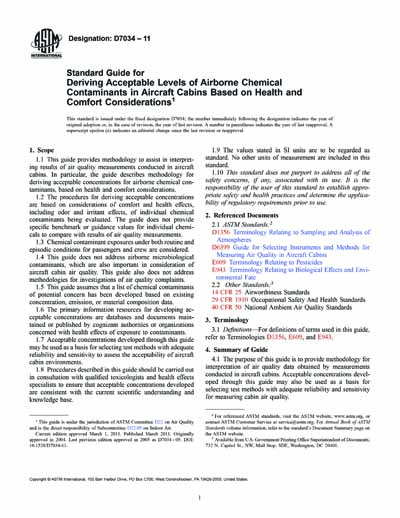Historical
ASTM D7034-05
Standard Guide for Deriving Acceptable Levels of Airborne Chemical Contaminants in Aircraft Cabins Based on Health and Comfort Considerations
1.1 This guide provides methodology to assist in interpreting results of air quality measurements conducted in aircraft cabins. In particular, the guide describes methodology for deriving acceptable concentrations for airborne chemical contaminants, based on health and comfort considerations.
1.2 The procedures for deriving acceptable concentrations are based on considerations of comfort and health effects, including odor and irritant effects, of individual chemical contaminants being evaluated. The guide does not provide specific benchmark or guidance values for individual chemicals to compare with results of air quality measurements.
1.3 Chemical contaminant exposures under both routine and episodic conditions for passengers and crew are considered.
1.4 This guide does not address airborne microbiological contaminants, which are also important in consideration of aircraft cabin air quality. This guide also does not address methodologies for investigations of air quality complaints.
1.5 This guide assumes that a list of chemical contaminants of potential concern has been developed based on existing concentration, emission, or material composition data.
1.6 The primary information resources for developing acceptable concentrations are databases and documents maintained or published by cognizant authorities or organizations concerned with health effects of exposure to contaminants.
1.7 Acceptable concentrations developed through this guide may be used as a basis for selecting test methods with adequate reliability and sensitivity to assess the acceptability of aircraft cabin environments.
1.8 Procedures described in this guide should be carried out in consultation with qualified toxicologists and health effects specialists to ensure that acceptable concentrations developed are consistent with the current scientific understanding and knowledge base.
This standard does not purport to address all of the safety concerns, if any, associated with its use. It is the responsibility of the user of this standard to establish appropriate safety and health practices and determine the applicability of regulatory requirements prior to use.
Content Provider
ASTM International [astm]






